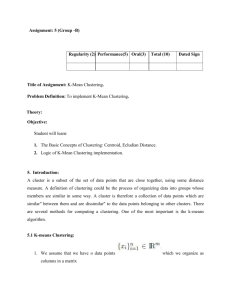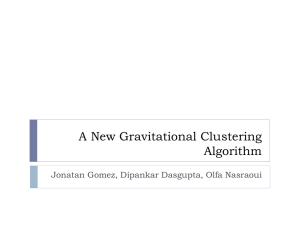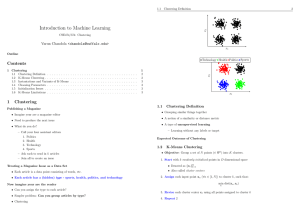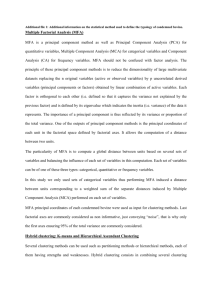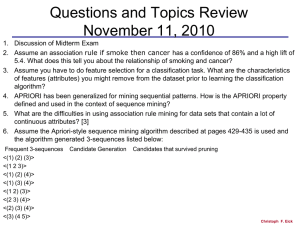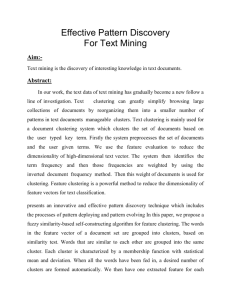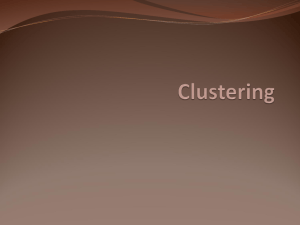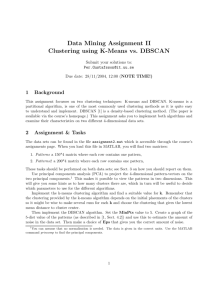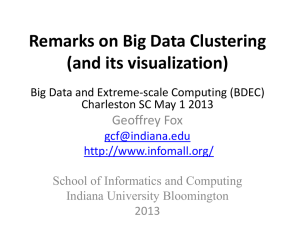pouryazdanpanah_ali_Kinect_based_Image_Segmentation
advertisement
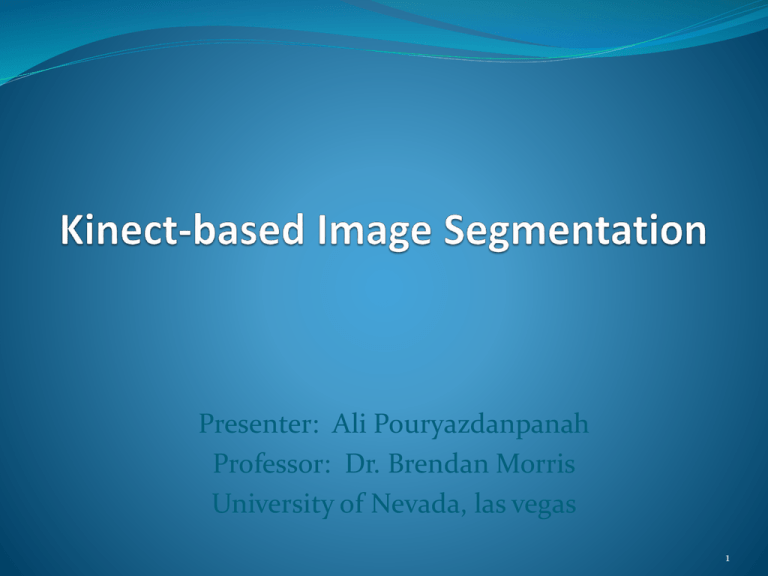
Presenter: Ali Pouryazdanpanah Professor: Dr. Brendan Morris University of Nevada, las vegas 1 Overview Intuition and basic algorithms (k-means) Advanced algorithms (spectral clustering) Extend the methods for Kinect device 2 Clustering: intuition 3 What is clustering, intuitively? Data set of “objects” Some relations between those objects (similarities, distances, neighborhoods, connections, ... ) Intuitive goal: Find meaningful groups of objects such that objects in the same group are “similar” objects in different groups are “dissimilar” Reason to do this: exploratory data analysis reducing the complexity of the data many more 4 Example: Clustering gene expression data 5 Example: Social networks Corporate email communication (Adamic and Adar, 2005) 6 Example: Image segmentation 7 The standard algorithm for clustering: K-means 8 K-means – the algorithm Given data points X1, ..., Xn 𝜖𝑅𝑛 . Want to cluster them based on Euclidean distances. Main idea of the K-means algorithm: Start with randomly chosen centers. Assign all points to their closest center. This leads to preliminary clusters. Now move the starting centers to the true centers of the current clusters. Repeat this until convergence. 9 10 11 12 13 Input: Data points X1, ..., Xn 𝜖𝑅𝑛 , number K of clusters to construct. 1- Randomly initialize the centers 2- Iterate until convergence: 2-1-Assign each data point to the closest cluster center, that is define the clusters 2.2 Compute the new cluster centers by Output: Clusters C1, ..., CK 14 K-means – summary Advantages: data automatically assigned to clusters The ideal algorithm for standard clustering Disadvantages: All data forced into a cluster (solution: fuzzy c-means clustering and its versions) Clustering models can depend on starting locations of cluster centers (solution: multiple clusterings) Unsatisfctory clustering result to convex regions 15 16 Spectral Clustering 17 First-graph representation of data (largely, application dependent) Then-graph partitioning In this talk–mainly how to find a good partitioning of a given graph using spectral properties of that graph 18 Graph Terminology 19 Graph Cuts Minimal bipartition cut Minimal bipartition normalized cut Problem: finding an optimal graph (normalized) cut is NP-hard Approximation: spectral graph partitioning 20 Algorithms Spectral clustering -overview Main difference between algorithms is the definition of A=func(W) 21 22 The “Ideal” case Eigenvectors are orthogonal Clustering rows of U correspond to clustering points in the ‘feature’ space 23 24 The perturbation theory explanation Ideal case: between-cluster similarities are exactly zero. Then: For L: all points of the same cluster are mapped on the identical point in 𝑅𝑘 Then spectral clustering finds the ideal solution. The stability of eigenvectors of a matrix is determined by the eigengap 25 Toy example with three clusters Data set in 𝑅2 similarity function with σ= 0.5 Use completely connected similarity graph Want to look at clusterings for k = 2,...,5 clusters 26 example with three clusters Each eigenvector is interpreted as a function on the data points: Xj j-th coordinate of the eigenvectors. This mapping is plotted in a color code: 27 example with three clusters The eigenvalues (plotted i vs. λi ): 28 29 30 31 Kinect 32 Kinect Introduction 33 Kinect-based Segmentation 34 Thank You Questions? 35



